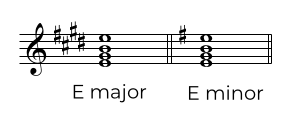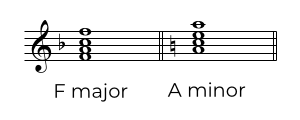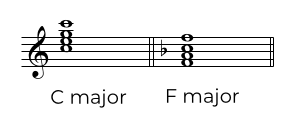Keys and modulations
Most pieces modulate, meaning a piece starts with one key, and then it goes to other keys before it returns to the original key. For instance, a piece in C major might go to G major and A minor before it returns to C major.
Some modulations sound natural and often we don't even notice. Then there are times when the modulation stands out and sounds abrupt. In this article, we will discuss how the keys are related, and what makes some modulations sound natural or abrupt.
Closely related keys

The diagram above shows the relationship between the keys. The keys framed in blue are closely related keys of C major.
Closely related keys are parallel key, relative key, dominant key, and subdominant key. Also, relative key of the dominant and subdominant keys are considered closely related keys. It's a little wordy, let's break it down and take a look at each of them.
Parallel key
Parallel key is a key that shares the same Tonic as the original key. For instance, C major and C minor are parallel keys, so are F major and F minor.


Relative key
Relative keys share the same key signature. For instance, both C major and A minor have no sharps or flats in the key signature, so they are relative keys.


Dominant key
A dominant is an interval of perfect 5th above the original note. For instance, if the original note is A♮, the dominant is E♮. The same rule applies to the keys, so the dominant key of A major would be E major.


Relative key of the dominant key
This one requires a two-step process. like this; first, the dominant key of C major is G major. Second, the relative key of G major is E minor. So, the relative key of the dominant key of C major is E minor. Refer to the diagram above to visually understand the correlation.


Subdominant key
A subdominant is an interval of perfect 4th above the original note. If the original note is A♮, the subdominant is D♮. so that means the subdominant key of A major is D major.


Relative key of the subdominant key
The subdominant key of C major is F major. The relative key of F major is D minor. So, the relative key of the subdominant key of C major is D minor.


Distantly related keys
What are distantly related keys? Basically, anything outside of closely related keys would be considered distantly related keys.
When music modulates to a distantly related keys, it sounds surprising, or disconnected from the previous key.
Examples
Parallel key

The example above from the recapitulation of the 1st movement of the Violin Sonata No.7 by Beethoven. The 1st theme starts in C minor, and it modulates into C major in the 2nd theme.
In the sonata form, It is typical that the 2nd theme is a parallel key of the 1st theme in the recap when the piece is written in a minor key.
Relative key

The example above starts in D minor, and quickly modulates to F major in measure 8.

This is an example of a relative key between the 1st and 2nd themes in a violin sonata by Beethoven. The first theme is in C minor, and the second theme is in Eb major.
In the sonata form, It is typical that the 2nd theme is a relative key of the 1st theme in the exposition when the piece is written in a minor key.
Dominant key

This example from a piano sonata by Mozart starts with a C major. Then it modulates into G major in the 2nd theme.
It is most common in the exposition of a sonata form that the 2nd theme is presented in the dominant key of the 1st theme.
Relative key of the dominant key

This example is from Violin Sonata No.8 by Beethoven. The initial key is E♭ major. Then it modulates to G minor. The transition from E♭ to G minor is very smooth in this particular example because it uses a G major chord which is a dominant chord of C minor (relative key of E♭ major) before it modulates to G minor.
Subdominant Key

The example above starts in C major, goes through a few chord changes from measure 5 to 8, then it ends up in F major in measure 11.
Relative key of the subdominant key

In this example above, the theme is presented in D minor before the Trio. There is a key change in the Trio, now we are in B♭ major, which is the relative key of the subdominant key of D minor.